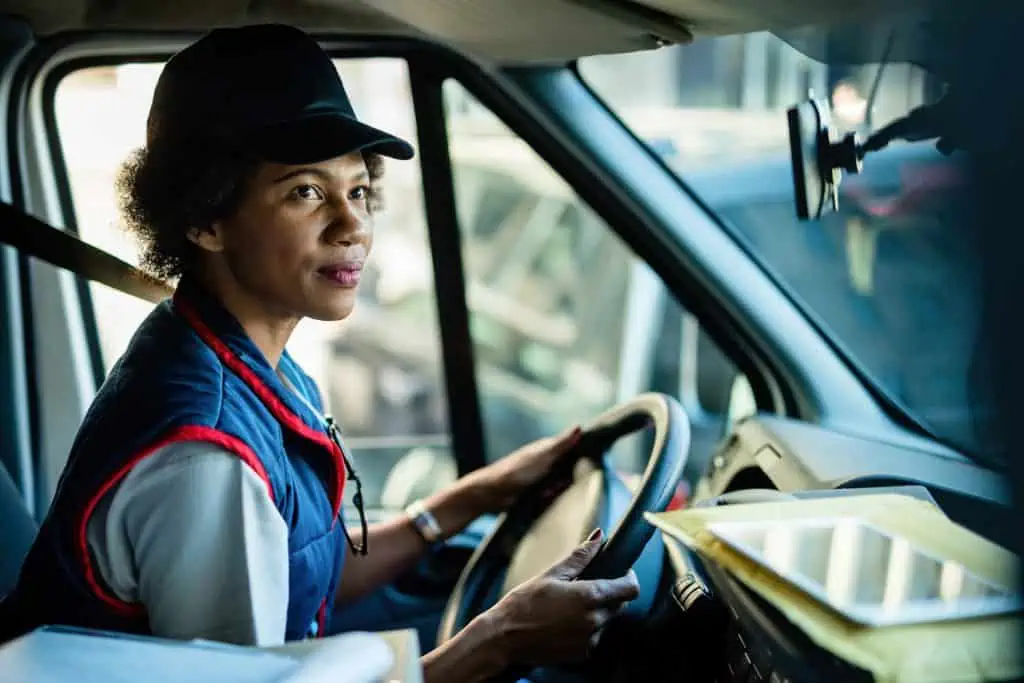Trucking and transportation industry frontline positions are historically male-dominated, with women representing 50% of the total population and only 13.7% of the trucker workforce
(Source: WIT Index Unveils Updated Percentages of Women in the Workforce, Redefining the Road, Fall 2022).
What can we do to increase women’s visibility and address matters of safety?
To illustrate the importance of increasing women’s presence in trucking and transportation, the Federal Motor Carrier Safety Administration (FMCSA) has created a Women of Trucking Advisory Board that will “focus on solutions to retain and recruit [female] drivers into the industry.” The board represents professional associations, non-profits, as well as large and small companies coming together with the common goal “to review and report on policies that provide education, training, mentorship, or outreach to women in the trucking industry and recruit, retain, or advance women in the trucking industry.”
When it comes to commercial truck driving, safety on the job is a top concern women have when deciding to begin this career. According to a 2021 survey by Women in Trucking, “Over 60% of female truck drivers felt unsafe at least once in the past year… and approximately 20% reported being threatened by a weapon and 4% said they had been [assaulted]” (Source: Automotive-Fleet.com). The low representation of women in commercial driving jobs is largely due to societal perception and traditional recruitment processes, which can also raise concerns about workplace safety for women in male-dominated careers such as CDL drivers.
A good place to start with safety is technology, which has made a big impact on transportation and our ability to connect anywhere. Below are key technology resources all drivers should carry on the job and suggested strategies companies can take to recruit and retain more female drivers.
Technology solutions that help promote safety on the road
Desiree Wood is the founder of Real Women in Trucking, a non-profit organization of women commercial truck drivers who advocate for female drivers’ safety. She is a passionate and dedicated truck driver and tirelessly campaigns for female drivers’ safety on the road.
Desiree recently chatted with Inflection Poynt about the most important safety technology for women truck drivers, as well as the importance of always having a plan in place for the worst-case scenario:
- For safety, especially from day one in training, we urge women to join a group like Real Women in Trucking or create a group with their friends that utilizes the Life360 app so your location is known and you can send an SOS for help.
- Technology that all drivers use for truck parking are GPS navigation specific to truck routes and apps like TruckerPath that help us find truck parking and tells us about available amenities like showers, laundry facilities, food options that are available there, etc.
- Real Women in Trucking also led an investigative report on Sexual Assault and Harassment in the industry; more information on this important topic can be found here.
- Our other organization is Truckers Emergency Assistance Responders. We help stranded truck drivers get home with their pets and belongings. Technically, it is not illegal to dump your worker in this industry in a state far from their home with no resources to get there. This can happen over a disagreement with your dispatcher, over an illness, or over a broken-down truck that the company or owner doesn’t want to fix.
- My #1 safety tip for women is to have a good plan in place for a worst-case scenario.
In addition, always have a CB Radio on hand, and set it to Channel 19. The CB Radio will always come in handy in areas of poor reception, and truckers can communicate about any hazards or weather/traffic issues on Channel 19.
Top Safety Tips for Waste and Recycling CDL drivers
Specifically in the waste and recycling industry, safe, new, and functional equipment attracts and retains top drivers and job candidates. Waste companies that provide the best and newest equipment and trucks send a clear message that they invest in the safety of their employees, customers, and communities.
Unfortunately, waste collection drivers are in the top 10 most dangerous jobs in the USA. The good news is the number of accidents and fatalities is decreasing as more awareness is brought to this issue. As of November 2022, “The [injury/fatality] rate for solid waste collection went from 5.2 to 4, and the rate for workers at MRFs fell from 5.2 to 3.2. The injury and illness rates…are at their lowest levels since at least 2006.”
According to the Solid Waste Association of North America, the top “5 to stay alive safety tips are:
- Always wear PPE, especially high-visibility vests and/or outerwear
- Never use your cell phone while driving the truck or at a disposal facility
- Don’t ride on the step if the truck is backing or going more than 10mph or 1/5th mile
- Always comply with safety belt rules
- Don’t exceed the speed limit and don’t rush.”
Building comradery and community among women in the workplace

Another important point is that technology has the ability to bring together a community. Women in any workplace environment need to build comradery and stick together. Joining Real Women in Trucking or a similar organization is a great place to start, in addition to finding Facebook groups with other women truck drivers. Even TikTok has become a very popular platform for drivers. Just don’t TikTok while you drive!
Tactics organizations can use to implement safety in the workplace
As a first step, organizations must start from the top down and implement policies and procedures to help women feel secure on the road at all times. Below are a few strategies being used by some companies to do just that.
- Provide Gender-Specific Training
Trucking companies should provide gender-specific training to help female truck drivers understand the challenges they may face in the industry. This could include topics such as safety, communication, and customer service.
- Implement Flexible Scheduling
Companies should look into flexible scheduling options for female truck drivers to make it easier for them to manage their time and fit in the job with other commitments.
- Establish Support Groups
Establishing support groups that are specifically for female truck drivers can help create a sense of community and provide a safe place to discuss issues and challenges specific to women.
- Offer On-the-Job Mentorship
Companies should look into providing on-the-job mentorship for female truck drivers. This can help them feel more supported and provide a space to ask questions and learn the ropes.
- Provide Transportation
Offering transportation to and from work can help make the job more accessible for female truck drivers who might not be able to afford to own their own vehicles.
- Create Incentives
Companies should create incentives to attract and retain female drivers. This could include competitive pay, bonuses, and other benefits.
- Establish a Comprehensive Harassment Policy
The policy should outline the consequences of any form of harassment and provide a clear path of recourse for victims.
Why a career as a CDL driver?

With all of the safety concerns around truck driving, what are the advantages? The answer is great pay and independence, of course! First, traditional schooling is not for everyone. A career as a commercial truck driver does not require a four-year degree, you only have to obtain a CDL license. Thus, there is a low barrier of entry, and women and drivers in general are in high demand. With such high demand for CDL drivers, employment is guaranteed, and companies are increasingly focusing their recruiting efforts on attractive bonus and benefits programs for drivers.
Cari Baylor, President of Baylor Trucking states the facts: “The industry offers competitive pay packages, with office wages meeting or exceeding those of other industries. The average annual wage for over-the-road tractor-trailer drivers is more than $40,000, with many drivers making more than $60,000, with the possibility of more than $100,000.”
So as companies continue their efforts around recruiting and retaining more of the female workforce, we hope these strategies and tech solutions will be a good starting point to opening up more lucrative and flexible job opportunities for women.



